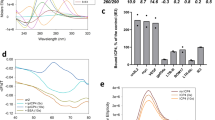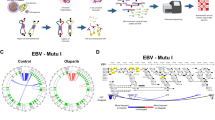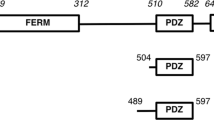Abstract
Enhancers are cis-act ing elements that activate transcription in higher eukaryotes independently of their position or orientation relative to the promoter that they activate1. The mechanisms by which enhancers activate transcription are poorly understood, in part because, with the exception of the glucocorticoid receptor2, the proteins that directly interact with enhancers have not been purified, nor have the genes encoding them been cloned3–5. The upstream regulatory region (URR) that immediately precedes the early genes of the bovine papillomavirus type 1 genome (BPV) has enhancer activity when it is activated by a trans-acting gene product of the BPV E2 open reading frame (ORF) (Fig. 1)6. It is not known whether this enhancement represents a direct or indirect effect of E2 on the URR. We have used an E2 peptide expressed in bacteria and a DNA-protein complex immunoprecipitation assay to study E2-mediated enhancement of transcription by the URR. We show here that this peptide directly binds to four specific sites in the BPV URR, and to one site in the human papillomavirus (H)PV16 URR. All the binding sites contain a related sequence of nucleotides; a 23 base pair (bp) fragment containing this sequence can specifically prevent binding of the E2 protein to the BPV URR. The BPV E2–URR enhancer interaction may therefore represent a useful model system for studying the mechanism of transcriptional enhancement, as both an effector protein and its target enhancer can be purified and genetically manipulated.
This is a preview of subscription content, access via your institution
Access options
Subscribe to this journal
Receive 51 print issues and online access
$199.00 per year
only $3.90 per issue
Buy this article
- Purchase on Springer Link
- Instant access to full article PDF
Prices may be subject to local taxes which are calculated during checkout
Similar content being viewed by others
References
Khoury, G. & Gruss, P. Cell 33, 313–314 (1983).
Weinberger, C. et al. Science 228, 740–742 (1985).
Bohnlein, E. & Gruss, P. Molec. cell Biol. 6, 1401–1411 (1986).
Singh, H., Sen, R., Baltimore, D. & Sharp, P. Nature 319, 154–158 (1986).
Wildeman, A. G. et al. Molec. cell Biol. 6, 2098–2105 (1986).
Spalholz, B., Yang, Y.-C. & Howley, P. M. Cell 42, 183–191 (1985).
Sarver, N., Rabson, M. S., Yang, Y.-C., Byrne, J. C. & Howley, P. M. J. Virol 52, 377–388 (1984).
DiMaio, D. J. Virol. 57, 475–480 (1986).
Keller, J. M. & Alwine, J. C. Cell 36, 381–389 (1984).
Setoyama, C., Frunzio, R., Liau, G., Mudryj, M. & de Crombrugghe, B. Proc. natn. Acad. Sci. U.S.A 83, 3213–3217 (1986).
Schiller, J. T., Vass, W. C. & Lowy, D. L. Proc. natn. Acad. Sci. U.S.A. 81, 7880–7884 (1984).
Yang, Y.-C., Spalholz, B. A., Rabson, M. S. & Howley, P. M. Nature 318, 575–577 (1985).
Schiller, J. T., Vass, W. C., Vousden, K. H. & Lowy, D. R. J. Virol 57, 1–6 (1986).
Groff, D. E. & Lancaster, W. D. Virology 150, 221–230 (1986).
Danos, O., Giri, I., Thierry, F. & Yaniv, M. J. invest. Derm. 83, 8s–11s (1984).
Heilman, C., Engel, L., Lowy, D. R. & Howley, P. M. Virology 119, 22–34 (1982).
Stenlund, A., Zabielski, J., Ahola, H., Moreno-Lopez, J. & Pettersson, U. J. molec. Biol. 182, 541–554 (1985).
Androphy, E. J., Schiller, J. T. & Lowy, D. R. Science 230, 442–445 (1985).
McKay, R. D. G. J. molec Biol. 145, 471–488 (1981).
Seedorf, K., Krammer, G., Durst, M., Suhai, S. & Rowekamp, W. G. Virology 145, 181–185 (1985).
Kriegler, M. & Botchan, M. Molec. cell. Biol. 3, 325–339 (1983).
Dartmann, K., Schwarz, E., Gissmann, L. & zur Hausen, H. Virology 151, 124–130 (1986).
Keegan, L., Gill, G. & Ptashne, M. Science 231, 699–704 (1986).
Herbomel, P., Bourachot, B. & Yaniv, M. Cell 39, 653–662 (1984).
Zenke, M. et al. EMBO J. 5, 387–397 (1986).
Dynan, W. S. & Tjian, R. Nature 316, 774–778 (1985).
Sawadogo, M. & Roeder, R. Cell 43, 165–175 (1985).
Kovesdi, I., Reichel, R. & Nevins, J. Cell 45, 219–228 (1986).
Felber, B. K., Paskalis, H., Klienman-Ewing, C., Wong-Staal, F. & Pavlakis, G. N. Science 229, 675–679 (1985).
Rosen, C. A., Sodroski, J. G., Kettman, R. & Haseltine, W. A. J. Virol 57, 738–744 (1986).
Lusky, M. L. & Botchan, M. R. Nature 293, 79–81 (1981).
Author information
Authors and Affiliations
Rights and permissions
About this article
Cite this article
Androphy, E., Lowy, D. & Schiller, J. Bovine papillomavirus E2 trans-activating gene product binds to specific sites in papillomavirus DNA . Nature 325, 70–73 (1987). https://doi.org/10.1038/325070a0
Received:
Accepted:
Issue Date:
DOI: https://doi.org/10.1038/325070a0
This article is cited by
-
Human papillomaviruses: diversity, infection and host interactions
Nature Reviews Microbiology (2022)
-
Epigenetic regulation of human papillomavirus transcription in the productive virus life cycle
Seminars in Immunopathology (2020)
-
Identification of a novel human papillomavirus by metagenomic analysis of vaginal swab samples from pregnant women
Virology Journal (2016)
-
Genomic characterization of a novel Epsilonpapillomavirus associated with pigmented papillomas in a red deer (Cervus elaphus)
Virus Genes (2016)
-
Genomic characterisation of Felis catus papillomavirus 4, a novel papillomavirus detected in the oral cavity of a domestic cat
Virus Genes (2014)
Comments
By submitting a comment you agree to abide by our Terms and Community Guidelines. If you find something abusive or that does not comply with our terms or guidelines please flag it as inappropriate.



